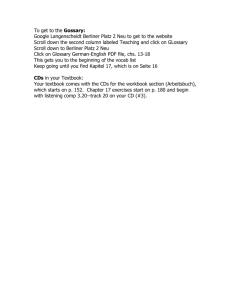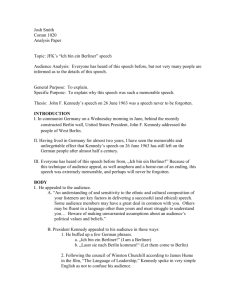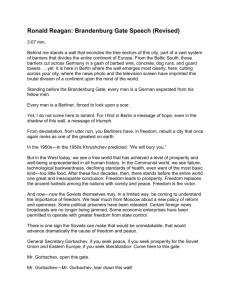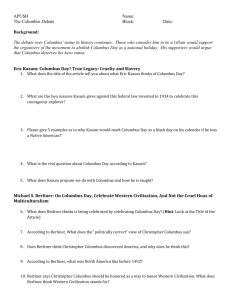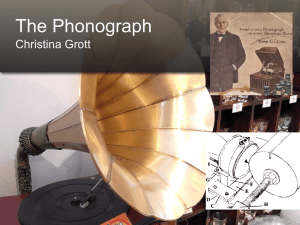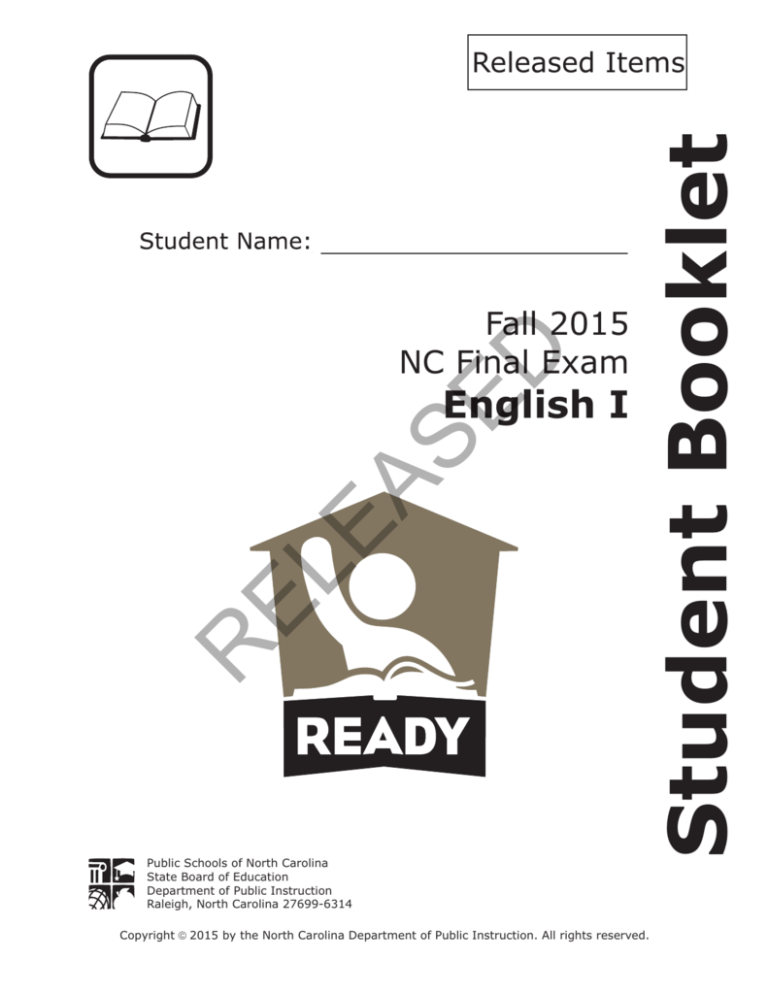
D
Fall 2015
NC Final Exam
R
EL
EA
SE
English I
Public Schools of North Carolina
State Board of Education
Department of Public Instruction
Raleigh, North Carolina 27699-6314
Copyright ã 2015 by the North Carolina Department of Public Instruction. All rights reserved.
Student Booklet
Released Items
ENGLISH I — RELEASED ITEMS
PART A of Excerpt from “A Piece of Red Calico”
by Frank Stockton
I was going into town the other morning when my wife handed me a little piece of red
calico and asked me if I would have time, during the day, to buy her two yards and a
half of calico like it. I assured her that it would be no trouble at all, and putting the piece
of calico in my pocket, I took the train for the city.
2
SE
D
At lunchtime I stopped in at a large dry-goods store to attend to my wife’s commission.
I saw a well-dressed man walking the floor between the counters, where long lines of
girls were waiting on much longer lines of customers, and asked him where I could see
some red calico.
“This way, sir,” and he led me up the store. “Miss Stone,” said he to a young lady, “show
this gentleman some red calico.”
EA
“What shade do you want?” asked Miss Stone.
EL
I showed her the little piece of calico that my wife had given me. She looked at it and
handed it back to me. Then she took down a great roll of red calico and spread it out on
the counter.
“Why, that isn’t the shade!” said I.
R
“No, not exactly,” said she. “But it is prettier than your sample.”
“That may be,” said I. “But, you see, I want to match this piece. There is something
already in my house, made of this kind of calico, which needs to be made larger, or
mended, or something. I want some calico of the same shade.”
The girl made no answer, but took down another roll.
“That’s the shade,” said she.
“Yes,” I replied, “but it’s striped.”
“Stripes are more worn than anything else in calicoes,” said she.
“Yes. But this isn’t to be worn. It’s for furniture, I think. At any rate, I want perfectly
plain stuff, to match something already in use.”
1
Go to the next page.
ENGLISH I — RELEASED ITEMS
“Well, I don’t think you can find it perfectly plain, unless you get Turkey red.”
“What is Turkey red?” I asked.
“Turkey red is perfectly plain in calicoes,” she answered.
“Well, let me see some.”
“We haven’t any Turkey red calico left,” she said, “but we have some very nice plain
calicoes in other colors.”
D
“I don’t want any other color. I want stuff to match this.”
20
SE
“It’s hard to match cheap calico like that,” she said, and so I left her.
21
EA
I next went into a store a few doors farther up Broadway. When I entered, I approached
the floorwalker, and handing him my sample, said:
“Have you any calico like this?”
EL
“Yes, sir,” said he. “Third counter to the right.” I went to the third counter to the right
and showed my sample to the salesman in attendance there. He looked at it on both
sides. Then he said:
R
“We haven’t any of this.”
“The floorwalker said you had,” said I.
“We had it, but we’re out of it now. You’ll get that goods at an upholsterer’s.”
I went across the street to an upholsterer’s.
“Have you any stuff like this?” I asked.
“No,” said the salesman, “we haven’t. Is it for furniture?”
“Yes,” I replied. . . .
I said no more, but left.
2
Go to the next page.
ENGLISH I — RELEASED ITEMS
“I saw a well-dressed man walking the floor between the counters.”
B
“ ‘Stripes are more worn than anything else in calicoes.’ ”
C
“ ‘I don’t want any other color. I want stuff to match this.’ ”
D
“I went across the street to an upholsterer’s.”
a payment for services
B
a request for advice
C
an investment
D
an assignment
SE
A
D
As used in paragraph 2, what is the narrator referencing with the word
commission?
EA
3
A
Based on the sentence below from paragraph 20, what is implied by the narrator’s
decision to leave?
EL
2
Which quote from the text represents the central idea?
“ ‘It’s hard to match cheap calico like that,’ she said.”
A
He feels insulted by the clerk’s statement.
B
He does not believe that the clerk is knowledgeable.
C
He does not like the fabric he found in that store.
D
He is angry because the store does not have what he needs.
R
1
3
Go to the next page.
ENGLISH I — RELEASED ITEMS
store supervisor
B
store salesman
C
store customer
D
store janitor
D
What is the source of the narrator’s frustration?
His wife makes him purchase fabric for her.
B
His wife is happier with the replacement fabric.
C
The salespeople are unwilling to help him find fabric.
D
No one can help him locate fabric that matches his sample.
SE
A
EA
6
A
What is the effect of the author’s use of dialogue in the text?
EL
5
Based on the text, which term has a similar meaning to the word floorwalker as
used in paragraph 21?
A
The vocabulary is difficult to understand.
B
The characters are clearly described.
C
The setting is open to interpretation.
D
The plot development is convincing.
R
4
4
Go to the next page.
ENGLISH I — RELEASED ITEMS
PART B of Excerpt from “A Piece of Red Calico”
by Frank Stockton
The next place I visited was a very large dry-goods store. Of the first salesman I saw, I
inquired if they kept red calico like my sample.
33
“You’ll find that on the second story,” said he.
36
SE
“Where shall I find red calico?”
D
I went upstairs. There I asked a man:
EA
“In the far room to the left,” and he pointed to a distant corner.
I walked through the crowds of purchasers and salespeople, around the counters and
tables filled with goods, to the far room to the left. When I got there, I asked for red
calico.
39
EL
“The second counter down this side,” said the man. I went there and produced my
sample. “Calicoes downstairs,” said the man.
R
“They told me they were up here,” I said.
“Not these plain goods. You’ll find them downstairs at the back of the store, over on that
side.”
I went downstairs to the back of the store.
“Where can I find red calico like this?” I asked.
43
“Next counter but one,” said the man addressed, walking with me in the direction
pointed out. “Dunn, show red calicoes.”
5
Go to the next page.
ENGLISH I — RELEASED ITEMS
Mr. Dunn took my sample and looked at it. “We haven’t this shade in that quality of
goods,” he said.
“Well, have you it in any quality of goods?” I asked.
“Yes. We’ve got it finer.” He took down a piece of calico and unrolled a yard or two of it.
“That’s not this shade,” I said. . . .
D
“I thought you weren’t particular about the match,” said the salesman. “You said you
didn’t care for the quality of the goods, and you know you can’t match without [taking]
into consideration quality and color both. If you want that quality of goods in red, you
ought to get Turkey red.” . . .
SE
49
EA
I turned on my heel, descended in the elevator, and went out on Broadway. I was
thoroughly sick of red calico. But I determined to make one more trial. My wife had
bought her red calico not long before, and there must be some to be had somewhere. I
ought to have asked her where she bought it, but I thought a simple little thing like that
could be procured anywhere.
50
EL
I went into another large dry-goods store. As I entered the door, a sudden tremor seized
me. I could not bear to take out that piece of red calico. If I had had any other kind of a
rag about me—a pen-wiper or anything of the sort—I think I would have asked them if
they could match that.
R
But I stepped up to a young woman and presented my sample, with the usual
question. . . .
“Have you any red calico like this?” I asked of the lady behind the counter.
“No, sir,” she said, “but we have it in Turkey red.”
Turkey red again! I surrendered.
“All right,” I said. “Give me Turkey red.”
“How much, sir?” she asked.
“I don’t know—say five yards.”
6
Go to the next page.
ENGLISH I — RELEASED ITEMS
58
The lady looked at me rather strangely, but measured off five yards of Turkey red calico.
Then she rapped on the counter and called out, “Cash!” A little girl, with yellow hair in
two long plaits, came slowly up. The lady wrote the number of yards; the name of the
goods; her own number; the price; the amount of the banknote I handed her; and some
other matters—probably the color of my eyes and the direction and velocity of the
wind—on a slip of paper. She then copied all this in a little book which she kept by her.
Then she handed the slip of paper, the money, and the Turkey red to the yellow-haired
girl. This young girl copied the slip in a little book she carried, and then she went away
with the calico, the paper slip, and the money.
D
59
EA
SE
After a very long time—during which the little girl probably took the goods, the money,
and the slip to some central desk, where the note was received, its amount and number
entered in a book; change given to the girl; a copy of the slip made and entered; girl’s
entry examined and approved; goods wrapped up; girl registered; plaits counted and
entered on a slip of paper and copied by the girl in her book; girl taken to a hydrant and
washed; number of towel entered on a paper slip and copied by the girl in her book;
value of my note and amount of change branded somewhere on the child, and said
process noted on a slip of paper and copied in her book—the girl came to me, bringing
my change and the package of Turkey red calico.
EL
I had time for but very little work at the office that afternoon, and when I reached
home, I handed the package of calico to my wife. She unrolled it and exclaimed:
R
“Why, this doesn’t match the piece I gave you!”
“Match it!” I cried. “Oh no! It doesn’t match it. You didn’t want that matched. You were
mistaken. What you wanted was Turkey red—third counter to the left. I mean, Turkey
red is what they use!”
My wife looked at me in amazement, and then I detailed to her my troubles.
“Well,” said she, “this Turkey red is a great deal prettier than what I had, and you’ve
bought so much of it that I needn’t use the other at all. I wish I had thought of Turkey
red before.”
“I wish from my heart you had!” said I.
7
Go to the next page.
ENGLISH I — RELEASED ITEMS
Which quote shows the narrator’s emotional development over the course of the
text?
A
“I went downstairs to the back of the store.”
B
“I was thoroughly sick of red calico. But I determined to make one more
trial.”
C
“The lady looked at me rather strangely, but measured off five yards of
Turkey red calico.”
D
“I had time for but very little work at the office that afternoon, and when I
reached home, I handed the package of calico to my wife.”
to emphasize a light and carefree mood
B
to create suspense and engage the reader
C
to challenge the reader to see more than one perspective
D
to raise the level of aggravation through the series of events
EA
A
EL
9
Based on paragraphs 33, 36, 39, and 43, why does the author choose to use
repeated experiences in this text?
Based on the context, which substitution could be made for the word procured in
paragraph 49?
R
8
SE
D
7
A
constructed
B
exhausted
C
acquired
D
fortified
8
Go to the next page.
ENGLISH I — RELEASED ITEMS
12
A
There is an earthquake as he is about to enter the store.
B
The idea of receiving another rejection is troubling to him.
C
He is disturbed by the thought that his wife will be upset with him.
D
He fears that he will have an outburst of anger toward the workers.
SE
D
In paragraph 58, how does the figurative language in the quote, “probably the
color of my eyes and the direction and velocity of the wind,” affect the tone of the
text?
It is the first visible example of sarcasm from the narrator since he began
his expedition.
B
It emphasizes how difficult it is for the narrator to go shopping during the
workday.
C
It is the first time the narrator is ashamed to ask for assistance from the
little girl.
D
It reveals the bitter feelings that the narrator has about the number of
salesclerks employed by fabric stores.
EA
A
EL
11
In paragraph 50, why does the narrator feel a “sudden tremor” as he enters the
dry-goods store?
R
10
In paragraphs 58 and 59, why did the narrator provide the specific details of his
transaction with the little girl?
A
to show how important the purchase was to the narrator’s wife
B
to show that the purchase was too expensive for the narrator
C
to show how complicated it was to make the purchase
D
to show that the purchase was unnecessary
9
Go to the next page.
ENGLISH I — RELEASED ITEMS
PART A of Emile Berliner
Emile (originally Emil) Berliner was born in Hanover, Germany, on May 20, 1851. He was
one of thirteen children born to Samuel and Sarah Fridman Berliner. . . . His father was
a merchant and a Talmudic1 scholar, and his mother was an amateur musician. From
both parents Berliner and his siblings inherited a great sense of integrity and a pride in
accomplishment.
2
EA
SE
D
Following a few years of school in Hanover, Berliner was sent to nearby Wolfenbüttel to
attend the Samsonschule from which he graduated in 1865 at the age of fourteen.
According to his own later statement, this marked the end of his formal schooling.
Berliner then spent several years at odd jobs in Hanover helping to support the large
Berliner family. Enticed by the offer of a clerkship in a store partly owned by a man
named Behrend, a Hanoverian who had emigrated to the United States some time
earlier, and perhaps by a desire to escape the military duty that faced most young men
in the year of the Franco-Prussian War, Berliner persuaded his parents to allow him to
accept the job offer and to emigrate to America. In late March 1870 he left Hanover.
R
EL
The dry-goods store for which he was destined was located in Washington, D.C. For
three years Berliner clerked for Gotthelf, Behrend and Co. until in 1873 he decided a
better opportunity awaited him in New York City. There Berliner again took up onerous2
jobs during the day while trying to improve himself by studying privately at night at the
Cooper Institute. After a brief career as a “drummer” (traveling salesman) for a “gents’
furnishings” (men’s clothing and accessories) establishment in Milwaukee, Berliner again
went back to New York where this time he was most fortunate in obtaining a position as
general cleanup man in the laboratory of Constantine Fahlberg, the discoverer of
saccharine. This experience in a research laboratory fired Berliner’s ambition, and he
decided that science, research, and invention were to be his destiny.
Work on the Telephone and the Microphone (1876–84)
4
In 1876 Berliner returned to what was now Behrend and Co. in Washington and resumed
his clerkship. That was the year of the American centennial celebrations, and among the
outstanding events that took place in Washington was a demonstration of the new
1
2
Talmudic: of or pertaining to the primary source of Jewish law and tradition
onerous: demanding
10
Go to the next page.
ENGLISH I — RELEASED ITEMS
SE
D
telephone of Alexander Graham Bell. Berliner saw the instrument for the first time and
was filled with enthusiasm. He commenced to study the telephone. To his inquiring mind
one of the instrument’s weaknesses was its transmitter. Working alone in his rooming
house, he fashioned a new type of transmitter which he called a “loose-contact”
transmitter, a type of microphone, which increased the volume of the transmitted voice.
That he was able to do this while still possessing only a rudimentary knowledge of
electricity and physics was quite astounding. When the members of the newly formed
American Bell Telephone Company were advised that a young and entirely unknown
man in Washington had submitted a caveat3 (Berliner wrote it himself without the aid of
a patent attorney) to the Patent Office covering a new transmitter, they could hardly
believe it. Thomas Watson, the Mr. Watson of telephone fame, was sent to Washington
to make inquiries. He returned such a glowing report of the transmitter and of Berliner
himself that the company offered to buy the rights to the invention and to hire Berliner
as a research assistant. For the next seven years, Berliner was employed by the
ABT Co., first in New York City and then in Boston. During those years Berliner worked
on numerous problems associated with the fledgling telephone industry and developed
into a first-class theoretical electrician.
EA
While working in Boston in 1881, Berliner became an American citizen and in the same
year married a young woman of German descent named Cora Adler. In 1884 Berliner
decided to set himself up as a private researcher and inventor, his cherished dream. He
resigned from the American Bell Telephone Company, and he and Cora left Boston and
set up housekeeping in Washington, D.C.
R
EL
In his small house in Washington, Berliner began working on additional improvements to
Bell’s telephone, selling the rights to his patents to the telephone company. Then, in
1886, he began working on the invention that was to prove his most important
contribution to the world. This was the development of the gramophone, the recording
and reproduction of sound by means of disc records. Among his other inventions were:
Floor Covering
As early as 1883, while still working for the telephone company, Berliner obtained
Patent 284,268 for a new type of floor covering which he termed Parquet Carpet. From
time to time he returned to this work, and he obtained additional Patents 621,316 in
1899 and 656,162 in 1900.
3
caveat: a legal notice
11
Go to the next page.
ENGLISH I — RELEASED ITEMS
Acoustic Tile
SE
D
As one who frequently attended orchestral concerts, operas, and other musical events,
as well as lectures, plays, and sermons, Berliner was well aware of the poor acoustics of
many halls, theaters, churches, and synagogues. Having studied acoustics for many
years, he decided to do something about the situation. He soon came up with a new
type of tile that could be affixed to the existing walls of rooms. Acoustic tiles were, in the
inventor’s words, “composed of porous cement, are as hard as stone, and yet have the
resonance of wood when vibrated by a tuning fork.” In 1926 he obtained
Patent 1,573,475 for these tiles. They were eminently successful in the days before
public address systems. Among the buildings that added these tiles were the auditorium
of Drexel University in Philadelphia, Stanley Theater in Jersey City, the Church of the
Messiah in Montreal, Leicester Theatre in London, Uptown Theater in Philadelphia, the
Second Presbyterian Church in Pittsburgh, and the boardroom of the Karachi Port Trust
in what is now Pakistan.
The Helicopter and the Lightweight Internal Combustion Engine
R
EL
EA
In 1906 or 1907 Emile Berliner became fascinated with the possibilities of the flying
machine. This led to his involvement in the development of the helicopter which, as he
himself said, was one of the earliest forms of heavier-than-air machines conceived,
going back at least as far as the time of Leonardo da Vinci. Berliner designed and
patented a new type of lightweight internal combustion engine to power the rotors. By
1909 he had constructed a working model that was capable of lifting the weight of two
adult men, however, the helicopter was tethered to the ground and no free flight was
attempted. Although Berliner had to relinquish his work on the helicopter, his son Henry
continued it.
12
Go to the next page.
ENGLISH I — RELEASED ITEMS
15
“He was one of thirteen children born to Samuel and
Sarah Fridman Berliner.”
B
“From both parents Berliner and his siblings inherited a great sense of
integrity and a pride in accomplishment.”
C
“Berliner then spent several years at odd jobs in Hanover helping to support
the large Berliner family.”
D
“In late March 1870 he left Hanover.”
D
A
SE
What does the word emigrate mean as used in paragraph 2?
to escape from war
B
to move to a new country
C
to attend school away from home
D
to travel a long distance to go to work
EA
A
EL
14
Which specific detail supports the central idea of the text?
Which of Berliner’s experiences helped him on the path to his first invention?
A
his modest childhood
B
his schooling in Germany
C
his travels to Washington
D
his position as a cleanup man
R
13
13
Go to the next page.
ENGLISH I — RELEASED ITEMS
16
What is the meaning of the word rudimentary in the sentence below from
paragraph 4?
“That he was able to do this while still possessing only a rudimentary knowledge of
electricity and physics was quite astounding.”
foreign
C
extensive
D
relentless
D
B
SE
Why did Emile Berliner decide “to do something about” the poor acoustics in many
public buildings?
He wanted to earn worldwide recognition as an inventor.
B
He realized that the tuning fork would be a lasting invention.
C
He installed cement tiles in auditoriums as one of his first jobs in America.
D
He was dedicated to improving sound technology for musical events and
vocal performances.
EA
A
EL
18
basic
How does the author unfold his analysis in this text?
R
17
A
A
by giving a chronological presentation of Emile Berliner’s inventions
B
by listing important events from Emile Berliner’s childhood in Milwaukee
C
by comparing and contrasting the work of Emile Berliner and Thomas Edison
D
by presenting evidence that Emile Berliner needed help to make his
discoveries
14
Go to the next page.
ENGLISH I — RELEASED ITEMS
Which quote supports the author’s idea that Emile Berliner cared about
technological advances in society more than personal gain?
A
“There Berliner again took up onerous jobs during the day while trying to
improve himself by studying privately at night at the Cooper Institute.”
B
“He commenced to study the telephone. To his inquiring mind one of the
instrument’s weaknesses was its transmitter.”
C
“For the next seven years, Berliner was employed by the ABT Co., first in
New York City and then in Boston.”
D
“In his small house in Washington, Berliner began working on additional
improvements to Bell’s telephone, selling the rights to his patents to the
telephone company.”
EA
How does the author make connections between Emile Berliner’s contributions and
accomplishments?
The author uses information about Berliner’s career to show his weak work
ethic.
B
The author uses subtitles to highlight the significant events in Berliner’s life.
C
The author uses the introduction to describe Berliner’s motivation.
D
The author uses a list to reveal Berliner’s unfinished inventions.
EL
A
R
20
SE
D
19
15
Go to the next page.
ENGLISH I — RELEASED ITEMS
PART B of Emile Berliner
Berliner’s Reputation and Other Inventors
10
EA
SE
D
Emile Berliner is not known to have had any testy relations with his inventor colleagues;
he appears to have been a man of remarkably even temperament. When certain slights
came his way it was not Berliner but some of his admirers who took up arms in defense
of his reputation. For instance, in the early years of the century, some writers took it
upon themselves to declare that it was Thomas A. Edison who had invented the
loose-contact telephone transmitter. Theodore Vail, president of the American Telephone
and Telegraph Company, wrote a letter declaring that to his certain knowledge it was
Emile Berliner who invented that type of microphone. Again, when Edison was presented
with a statue of Orpheus Discovering the Gramophone Record, it was not Berliner but a
host of his friends who complained, as they also did when Congress was considering
awarding Edison a medal for the development of the gramophone, in addition to his
numerous authentic inventions.
11
EL
Still, that Berliner was concerned about his reputation and noted the dubious claims of
others is evident from the Library of Congress’s collections. The Library has a scrapbook
apparently compiled by Berliner with articles and letters relating to Thomas Edison’s
receiving credit for Berliner’s invention of the gramophone. Likewise, Berliner wrote in
the front cover of a volume of telephone litigation that it might be necessary to preserve
this book in order to protect his reputation.
R
Involvement in Community and Social Causes
Emile Berliner for many years took an active role in community and social causes,
particularly in the public health field. In 1909 he donated funds for an infirmary building
at the Starmont Tuberculosis Sanitarium in Washington Grove, Maryland, dedicated to
the memory of his father. Berliner was president of the Washington Tuberculosis
Association for some years. In 1924, he inaugurated* the Bureau of Health Education to
promote public hygiene and health education for mothers and children.
13
The subject of children’s health was close to his heart. In 1900 his youngest daughter,
*
inaugurated: made a formal beginning of
16
Go to the next page.
ENGLISH I — RELEASED ITEMS
Alice, became desperately ill, very likely from bacteria picked up from some food or
drink. Because of this illness, Berliner campaigned against the high mortality rate of
babies and young children. He became a fervent advocate of clean milk, and by all
means at his disposal, he preached to mothers to “scald the milk” before serving it. He
also became disgusted by what he perceived to be the neglect of cleanliness in children.
In 1919 he and some of his associates wrote and published a book of colored drawings
with accompanying rhymes illustrating what happens to children who neglect
cleanliness. Entitled Muddy Jim, the book was given to schools in the Washington area
and elsewhere. All the rhymes were written by Emile Berliner. The book was soon
translated into French, possibly for distribution in the Canadian province of Quebec. . . .
EA
Berliner’s Death (1929)
SE
D
Berliner inherited a great fondness for music from his mother and was an avid
concertgoer. That he could play the piano is attested by one of his assistants in the
gramophone laboratory, who said that Berliner was the pianist on some of the very early
recordings. In 1897 he wrote a song entitled “Columbian Anthem” in honor of the
nation’s capital, the District of Columbia. It was arranged for male quartet and was
recorded in 1897 on Berliner record 4288 and seems to have been rerecorded several
times before June 1900.
In a May 9, 1928, letter to his wife concerning the type of funeral he would want,
Berliner expressed both his humanitarian and patriotic feelings:
R
EL
When I go I do not want an expensive funeral. Elaborate funerals are almost a criminal
waste of money. I should like Alice to play the first part of the “Moonlight Sonata” and at
the close maybe Josephine will play Chopin’s “Funeral March.” Give some money to
some poor mothers with babies and bury me about sunset. I am grateful for having lived
in the United States and I say to my children and grandchildren that peace of mind is
what they should strive for.
Emile Berliner died on August 3, 1929, in his seventy-ninth year.
17
Go to the next page.
ENGLISH I — RELEASED ITEMS
by the description of friends who supported Emile Berliner
B
by the locations where Emile Berliner’s experiments took place
C
by the summary of Emile Berliner’s successful inventions and good deeds
D
by the inclusion of historical figures who were familiar with Emile Berliner
D
Which key idea is the author presenting in paragraph 10?
Emile Berliner was ridiculed by his inventor colleagues.
B
Emile Berliner always received credit for his inventions.
C
Emile Berliner’s fame caused other inventors to copy his work.
D
Emile Berliner’s inventions were often accredited to Thomas Edison.
SE
A
EA
23
A
Based on paragraph 11, why was it necessary for Emile Berliner to take action?
A
He knew all inventions must be registered with the Library of Congress.
B
He wanted to document and receive acknowledgment for his inventions.
C
He learned his ideas were being published without his permission.
D
He believed the Library of Congress would protect his work.
EL
22
How is the central idea developed over the course of the text?
R
21
18
Go to the next page.
ENGLISH I — RELEASED ITEMS
to show that he was an inventor and a doctor
B
to show that he was trying to protect his family
C
to show that he was concerned about social issues
D
to show that he was very experienced in the medical field
A
stern lecturer
B
considerate nurturer
C
passionate supporter
D
disagreeable manager
SE
D
In paragraph 13, what does the phrase “fervent advocate” mean?
EA
26
A
Which statement supports the author’s claim that Emile Berliner was “a man of
remarkably even temperament”?
EL
25
Why does the author include information about Emile Berliner’s effort toward
improving public health?
A
“When certain slights came his way it was not Berliner but some of his
admirers who took up arms in defense of his reputation.”
B
“Emile Berliner for many years took an active role in community and social
causes, particularly in the public health field.”
C
“Because of this illness, Berliner campaigned against the high mortality rate
of babies and young children.”
D
“Berliner inherited a great fondness for music from his mother and was an
avid concertgoer.”
R
24
19
Go to the next page.
ENGLISH I — RELEASED ITEMS
A
Emile Berliner acquired a bad reputation with other inventors.
B
Emile Berliner learned to speak French in order to move to Quebec.
C
Emile Berliner wrote Muddy Jim to inform children about cleanliness.
D
Emile Berliner led a campaign to prevent mothers from giving milk to babies.
D
How are the author’s claims developed in the text?
through a description of Emile Berliner’s early recordings
B
by providing examples of Emile Berliner’s achievements
C
through testimonials of Emile Berliner’s reputation
D
by documenting Emile Berliner’s patents in a book
EA
SE
A
EL
28
Which statement provides support for the central idea of the text?
R
27
20
Go to the next page.
ENGLISH I — RELEASED ITEMS
This is the end of the English I Released Items.
Directions:
1. Look back over your answers for the test questions.
2. Make sure all your answers are entered on the answer sheet. Only what is
entered on your answer sheet will be scored.
3. Put all of your papers inside your test book and close the test book.
SE
D
4. Stay quietly in your seat until your teacher tells you that testing is
finished.
R
EL
EA
5. Remember, teachers are not allowed to discuss items from the test with
you, and you are not allowed to discuss with others any of the test
questions or information contained within the test.
21
D
SE
EA
EL
R
ACKNOWLEDGMENTS
The North Carolina Department of Public Instruction wishes to express gratitude to the following
authors and publishers, whose generous permission to reprint literary selections has made these
tests possible. Every effort has been made to locate the copyright owners of material reprinted in
this test booklet. Omissions brought to our attention will be corrected in subsequent editions.
Excerpt from “A Piece of Red Calico” by Frank R. Stockton, 1884, from The Magic Egg and Other
Stories by Frank R. Stockton, 1908.
“Emile Berliner” from Emile Berliner and the Birth of the Recording Industry, Special Presentation:
“Emile Berliner: Inventor of the Gramophone.” Library of Congress, Motion Picture, Broadcasting
and Recorded Sound Division.
ENGLISH I — RELEASED ITEMS
Type2
Key
1
MC
C
90%
RL.9-10.2
2
MC
D
83%
L.9-10.4.A
3
MC
A
66%
RL.9-10.1
4
MC
A
49%
5
MC
D
6
MC
D
7
MC
B
93%
RL.9-10.3
8
MC
D
79%
RL.9-10.5
10
11
Standard
SE
RL.9-10.4
RL.9-10.1
42%
RL.9-10.5
EA
88%
MC
C
72%
L.9-10.4.A
MC
B
88%
RL.9-10.1
R
9
Percent Correct3
D
Item Number
EL
English I
RELEASED Items1
Fall 2015
Answer Key
MC
A
71%
L.9-10.5.A
MC
C
84%
RL.9-10.3
13
MC
B
68%
RI.9-10.2
14
MC
B
81%
RI.9-10.4
15
MC
D
37%
RI.9-10.2
16
MC
A
54%
L.9-10.4.A
12
1
ENGLISH I — RELEASED ITEMS
Type2
Key
17
MC
D
75%
RI.9-10.1
18
MC
A
77%
RI.9-10.3
19
MC
D
83%
RI.9-10.5
20
MC
B
55%
RI.9-10.3
21
MC
C
61%
RI.9-10.2
22
MC
D
75%
23
MC
B
24
MC
C
25
MC
C
49%
L.9-10.4.A
26
MC
A
81%
RI.9-10.5
27
MC
C
67%
RI.9-10.2
MC
B
60%
RI.9-10.5
SE
RI.9-10.6
71%
RI.9-10.8
66%
RI.9-10.3
EA
EL
Standard
R
28
Percent Correct3
D
Item Number
These released items were administered to students during a previous test administration. This
sample set of released items may not reflect the breadth of the standards assessed and/or the
range of item difficulty found on the NC Final Exam. Additional information about the NC Final
Exam is available in the Assessment Specification for each exam located at
http://www.ncpublicschools.org/accountability/common-exams/specifications/.
1
This NC Final Exam contains only multiple-choice (MC) items.
2
Percent correct is the percentage of students who answered the item correctly during a
previous administration.
3
2
ENGLISH I — RELEASED ITEMS
Standard Descriptions
Only standard descriptions addressed by the released items in this booklet are listed below.
A complete list of standards for English Language Arts and Mathematics may be reviewed at
http://www.ncpublicschools.org/curriculum/languagearts/scos/
RL.9-10.1 (Reading Literature)
Cite strong and thorough textual evidence to support analysis of what the text says explicitly as
well as inferences drawn from the text.
D
RL.9-10.2 (Reading Literature)
Determine a theme or central idea of a text and analyze in detail its development over the
course of the text, including how it emerges and is shaped and refined by specific details;
provide an objective summary of the text.
SE
RL.9-10.3 (Reading Literature)
Analyze how complex characters (e.g., those with multiple or conflicting motivations) develop
over the course of a text, interact with other characters, and advance the plot or develop the
theme.
EA
RL.9-10.4 (Reading Literature)
Determine the meaning of words and phrases as they are used in the text, including figurative
and connotative meanings; analyze the cumulative impact of specific word choices on meaning
and tone (e.g., how the language evokes a sense of time and place; how it sets a formal or
informal tone).
EL
RL.9-10.5 (Reading Literature)
Analyze how an author’s choices concerning how to structure a text, order events within it
(e.g., parallel plots), and manipulate time (e.g., pacing, flashbacks) create such effects as
mystery, tension, or surprise.
R
L.9-10.4.A (Language)
Determine or clarify the meaning of unknown and multiple-meaning words and phrases based on
grades 9–10 reading and content, choosing flexibly from a range of strategies: Use context
(e.g., the overall meaning of a sentence, paragraph, or text; a word’s position or function in a
sentence) as a clue to the meaning of a word or phrase.
L.9-10.5.A (Language)
Demonstrate understanding of figurative language, word relationships, and nuances in word
meanings: Interpret figures of speech (e.g., euphemism, oxymoron) in context and analyze their
role in the text.
RI.9–10.1 (Reading Informational)
Cite strong and thorough textual evidence to support analysis of what the text says explicitly as
well as inferences drawn from the text
3
ENGLISH I — RELEASED ITEMS
RI.9–10.2 (Reading Informational)
Determine a central idea of a text and analyze its development over the course of the text,
including how it emerges and is shaped and refined by specific details; provide an objective
summary of the text.
RI.9–10.3 (Reading Informational)
Analyze how the author unfolds an analysis or series of ideas or events, including the order in
which the points are made, how they are introduced and developed, and the connections that
are drawn between them
RI.9–10.4 (Reading Informational)
Determine the meaning of words and phrases as they are used in a text, including figurative,
connotative, and technical meanings; analyze the cumulative impact of specific word choices on
meaning and tone (e.g., how the language of a court opinion differs from that of a newspaper).
SE
D
RI.9–10.5 (Reading Informational)
Analyze in detail how an author’s ideas or claims are developed and refined by particular
sentences, paragraphs, or larger portions of a text (e.g., a section or chapter).
RI.9–10.6 (Reading Informational)
Determine an author’s point of view or purpose in a text and analyze how an author uses
rhetoric to advance that point of view or purpose.
R
EL
EA
RI.9–10.8 (Reading Informational)
Delineate and evaluate the argument and specific claims in a text, assessing whether the
reasoning is valid and the evidence is relevant and sufficient; identify false statements and
fallacious reasoning
4

